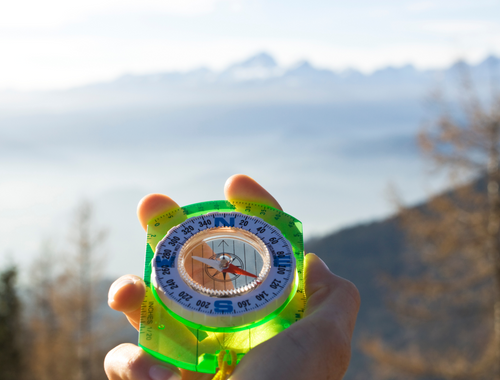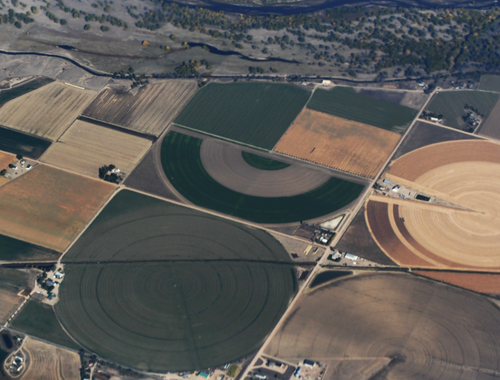Difference Between Azimuth and Altitude
In astronomy and navigation, when you want to identify and determine the position of an object in the sky, you must have a frame of reference or coordinate system, which assigns a different pair of numbers to every point in the sky. Now, azimuth and altitude are two horizon coordinates used to locate uniquely the position of an object. These are measures to determine the position and direction of celestial objects relative to an observer on the earth’s surface. The references in the system are the observer’s horizon plane (the earth or sea). Although, they may sound similar, they are not the same. Both are different angular measurements.

Azimuth
Azimuth is a horizontal angular measurement that specifies the direction of a celestial object, relative to an observer on the ground. It is measured clockwise in degrees around the observer’s horizon and a celestial body such as stars, planets, and the sun. Azimuth basically tells you which direction to face. It refers to ‘how far round’ from the north direction, also measured in degrees, with 0° being North, 90° being East, 180° being South, and 270° being West. So, the direction of a celestial body from the observer’s horizon, expressed as the angular distance from the true north is referred to as the azimuth angle. In Europe, azimuth is measured from the south, with west being taken as positive. The azimuth angle can be used to locate the position of celestial objects, navigate ships and aircraft, and conduct surveys of the land and the sky.

Altitude
If azimuth refers to ‘how far round’ from the north direction, altitude refers to ‘how far up’ in degrees. Altitude is the measurement of the vertical distance of an object in the sky, relative to an observer in the ground. It is the distance of an object or point relative to sea level or ground level. Like azimuth, it is measured in degrees, with 0° being at the horizon and 90° being directly overhead. Simply put, altitude is the perpendicular distance from a point to a line or a surface. It is the angular distance of a celestial body above the horizon. It is calculated by drawing a line from the observer to the object, and measuring the angle between that line and the observer’s horizon. So, altitude is angular distance of an object above the local horizon.
Different between Azimuth and Altitude
Definition
– Azimuth is a horizontal angular measurement that specifies the direction of a celestial object, relative to an observer on the ground. It the direction of a celestial body from the observer’s horizon, expressed as the angular distance from the true north. Altitude, on the other hand, is the measurement of the vertical distance of an object in the sky, relative to an observer in the ground. It is the angular distance of a celestial body above the horizon.
Measurement
– Azimuth tells you which direction to face and is measured in degrees, with 0° being North, 90° being East, 180° being South, and 270° being West. Azimuth refers to ‘how far round’ from the north direction. Altitude, on the other hand, refers to ‘how far up’ from the ground or sea level. It is also measured in degrees, but with 0° being at the horizon and 90° being directly overhead. So, altitude is angular distance of an object above the local horizon.
Azimuth vs. Altitude: Comparison Chart

Summary
So, azimuth and altitude both are angular measurements used to determine the apparent position of an object in the sky, relative to a specific point of observation. The observer is usually (but not necessarily) on the earth’s surface. Both are horizontal coordinates used to identify and locate a celestial object. These measurements are particularly used in astronomy and navigation. Azimuth is the horizontal angle that determines the direction of an object in the sky whereas altitude is the vertical angle that determines the height of an object in the sky, relative to an observer on the earth’s surface.
How do you find azimuth and altitude?
Azimuth is the horizontal angle between the reference direction and a point of interest, typically measured in degrees clockwise from North. Altitude is measured in degrees, with 0° being at the horizon and 90° being directly overhead.
Why does altitude and azimuth change?
Generally, altitude and azimuth change due to the changing position of the observer and the celestial object. The position of celestial objects like sun, moon and the planets changes due to the rotation of the earth. Additionally, atmospheric refraction, the bending of light as it passes through the Earth’s atmosphere, may also affect the azimuth and altitude of celestial objects.
What is azimuth in simple terms?
In simple terms, Azimuth is the direction of a celestial body from the observer’s horizon, expressed as the angular distance from the true north.
What are the altitude and azimuth of a star?
The altitude of a star is the angular distance of the star above the observer’s horizon, measured in degrees upwards from the horizon. The azimuth of a star is the horizontal angle between a reference direction, typically north, and the star.
What is the opposite of azimuth?
The opposite of azimuth would be azimuth measured in the opposite direction. For example, if azimuth is measured as 55 degrees clockwise from North, its opposite would be 305 degrees (360 – 55) counterclockwise from North.
What direction is azimuth?
The azimuth is the angle between North and the point of interest, measured clockwise along the horizon circle.
- Difference Between Caucus and Primary - June 18, 2024
- Difference Between PPO and POS - May 30, 2024
- Difference Between RFID and NFC - May 28, 2024
Search DifferenceBetween.net :
Leave a Response
References :
[0]Duffet-Smith, Peter. Practical Astronomy with Your Calculator. Cambridge, United Kingdom: Cambridge University Press, 1988. Print
[1]Smart, W.M. Textbook on Spherical Astronomy. Cambridge, United Kingdom: Cambridge University Press, 1977. Print
[2]Popko, Edward S. and Christopher J. Kitrick. Divided Spheres: Geodesics and the Orderly Subdivision of the Sphere. Florida, United States: CRC Press, 2021. Print
